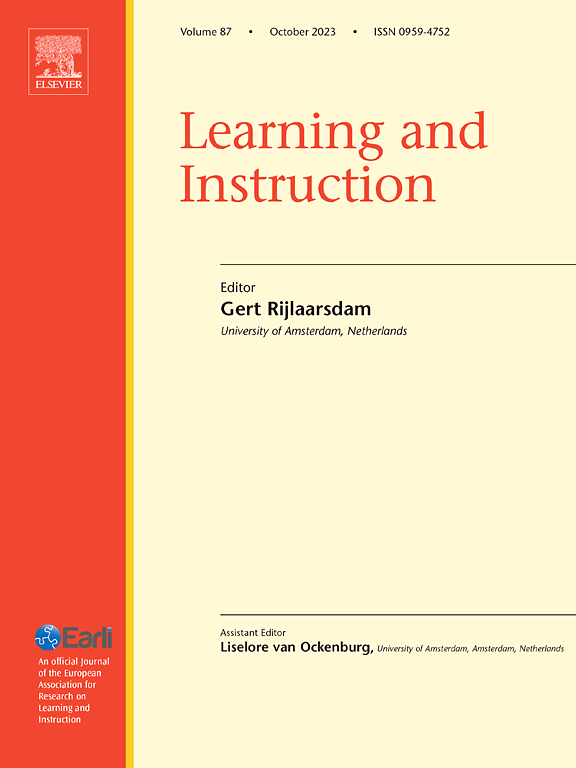一种基于力量的方法来探索学龄前儿童的空间语言和模式技能
IF 4.9
1区 教育学
Q1 EDUCATION & EDUCATIONAL RESEARCH
引用次数: 0
摘要
在空间语言和模式技能方面的缺陷在边缘化群体中表现得不成比例。然而,“缺陷模型”并没有考虑儿童在传统的基于测试的评估之外的环境中发挥的技能。评估环境(例如,基于测试还是基于游戏)可能会影响这些技能的表现。目的比较来自不同地理位置和社会经济优势水平(SEA)的儿童在基于游戏和基于测试的评估环境中的空间语言和模式技能。样本:来自大都市、区域城市和农村地区的学龄前儿童(平均年龄为4岁11个月,标准差为6个月)(N = 402空间语言,N = 439图案)。方法通过基于游戏和基于测试的评估,比较空间语言和空间模式的数字测量的表现。结果在地理和SEA的语言和模式测试评估中发现了显著的主要影响,以及显著的相互作用。在这些指标上,农村地区的儿童表现优于大都市和地方城市的儿童,高SEA社区的儿童表现优于低SEA社区的儿童。SEA对基于测试的评估的影响在城市样本中最为明显。SEA或地理对基于游戏的评估没有显著影响。结论评价情境对边缘学生空间语言和模式技能的影响较为明显。目前的措施可能无法完全反映儿童的能力。此外,在农村社区儿童中发现的优越的空间技能可以用来支持传统教育环境中的表现。本文章由计算机程序翻译,如有差异,请以英文原文为准。
A strength-based approach to exploring pre-school children’s spatial language and patterning skills
Background
Deficits in spatial language and patterning skills are disproportionately represented amongst marginalized groups. However, ‘deficit models’ do not consider children's enactment of skills within contexts other than traditional test-based assessment. It is possible that assessment context (e.g., test-based versus game-based) influences the manifestation of these skills.
Aims
To compare the spatial language and patterning skills of children in game-based and test-based assessment contexts drawn from different geographic locations and levels of socio-economic advantage (SEA).
Sample
Preschool children (Mean age = 4 years, 11 months, S.D. = 6 months) from Metropolitan Cities, Regional Cities, and Rural Areas (N = 402 for spatial language, N = 439 for patterning).
Methods
Performance was compared on digital measures of spatial language and spatial patterning through game-based and test-based assessment.
Results
Significant main effects were found for performance on language and patterning test-based assessments for Geography and SEA, as well as significant interactions. Children from rural areas outperformed children from metropolitan and regional cities, and children from High SEA communities outperformed children from Low SEA communities on these measures. The effects of SEA on test-based assessment were most pronounced in city samples. There were no significant effects for SEA or Geography on game-based assessment.
Conclusions
The results highlight the impact of assessment context on measurement of spatial language and patterning skills for marginalized students. Current measures may not entirely capture children's capabilities. Furthermore, the superior spatial skills found amongst children from rural communities could be capitalized upon to support performance in traditional education settings.
求助全文
通过发布文献求助,成功后即可免费获取论文全文。
去求助
来源期刊

Learning and Instruction
Multiple-
CiteScore
11.30
自引率
4.80%
发文量
109
期刊介绍:
As an international, multi-disciplinary, peer-refereed journal, Learning and Instruction provides a platform for the publication of the most advanced scientific research in the areas of learning, development, instruction and teaching. The journal welcomes original empirical investigations. The papers may represent a variety of theoretical perspectives and different methodological approaches. They may refer to any age level, from infants to adults and to a diversity of learning and instructional settings, from laboratory experiments to field studies. The major criteria in the review and the selection process concern the significance of the contribution to the area of learning and instruction, and the rigor of the study.
 求助内容:
求助内容: 应助结果提醒方式:
应助结果提醒方式:


